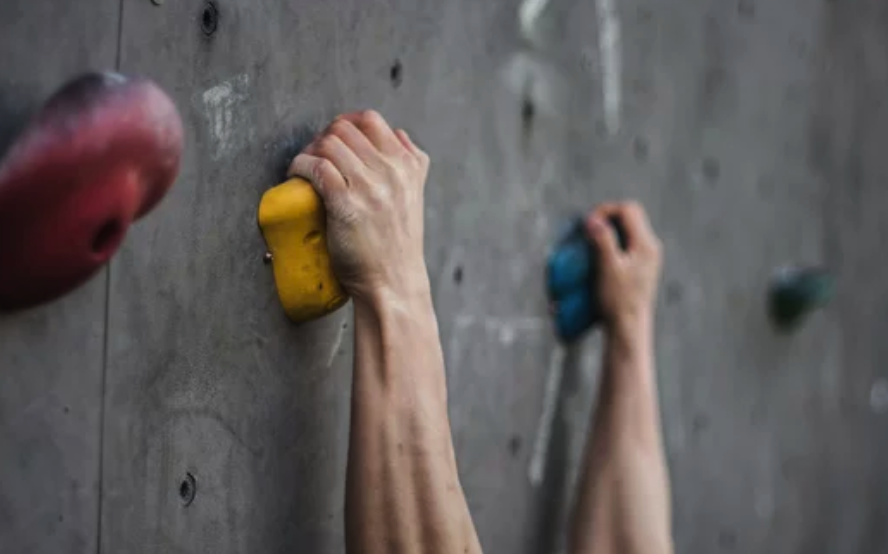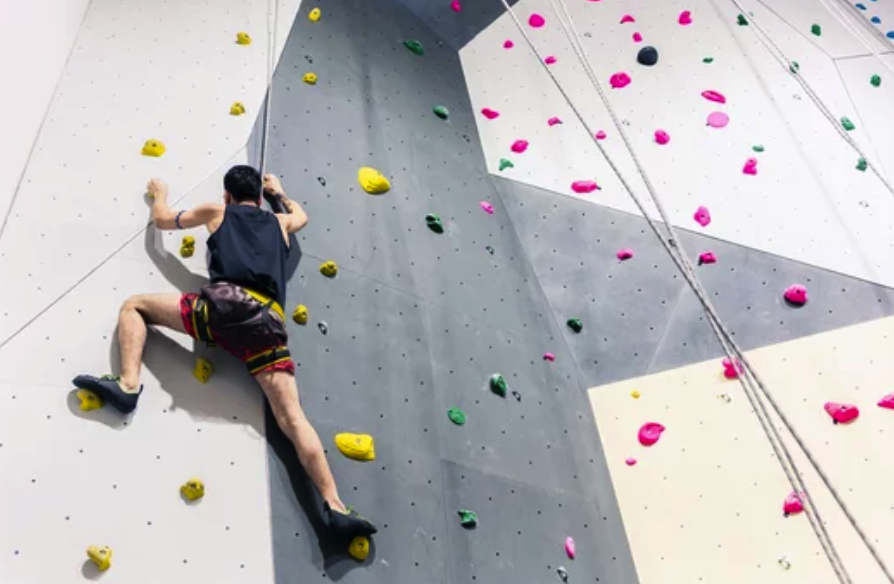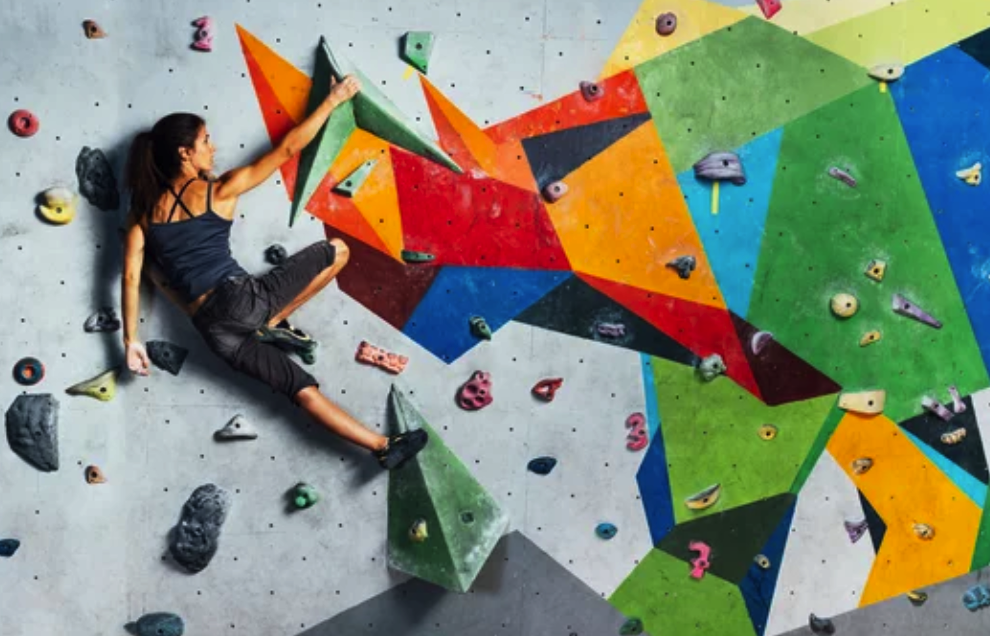Table of Contents
Whether injury or corona lockdown, getting back into climbing after a break is tough! With these tips it goes better – and you get fit again faster!
After a break, it’s hard to get started. You feel overall unfit – and usually are. To make sure that the start into training or even just into “normal” climbing works well and painlessly, there are some sensible approaches that we explain here.
For a successful comeback keep this in mind
When the halls open again and the rocks dry, the season starts up again. Those of us who haven’t regularly held onto our own climbing wall in the loft, or at least the fretboard, will have to prepare for a tough start in the process. The strength is gone, the feeling for movement even more so, and the head? …you probably have to be especially lenient with it in the beginning. But from the beginning.
Of course, not everything will run smoothly right away, and after a few months’ break, you won’t be able to start right back where you left off. But that doesn’t automatically mean that your comeback will be a grumpy one. On the contrary, with our tips you can get back into the climbing business quickly and in good health.
Studies have shown that even after several months off, it doesn’t take an inordinate amount of time to get back to your previous level. However, in order to do this without injury, it is important to remember that without training, not only does muscle strength diminish, but so does the resistance of tendons, ligaments and joints (see interview with climbing doctor Andreas Schweizer). Their strength shrinks during a period of non-exertion in a similar way to that of the muscles: After all, our body is efficient and breaks down what is not needed. That’s why it’s better to start off too carefully than too briskly, and – as a guide – only estimate about half the intensity and also the volume of what you felt was normal before the break. The exception is frequency: To start, it makes sense to give your body a stimulus more often, but it should be too light rather than too intense. In other words: Go climbing or bouldering more often in the beginning, but not for as long and not as hard (the optimal starting program is explained below).
Our central nervous system (CNS) is responsible for our motor skills and therefore largely responsible for how cleanly we execute certain moves and sequences. That’s why coordination drops significantly when we’re tired or stressed, for example.
Even though climbing movements are not easily unlearned, the sequences must first be refreshed before we can move smoothly and routinely in the vertical again. Incidentally, this also applies to those training at home: after all, hard moves on the 40-degree wall in the basement or hanging on the fingerboard hardly prepare us for difficult slab pushing, nor for many other moves that we usually call up on the rock or on the rope. This argues for paying attention to variety in movements and climbing a lot of different easy and intermediate stuff in the beginning.
Don’t worry, be happy!
Most of us will start again full of joy and not waste a thought on what is not going so well just yet. And that is exactly right! Fun is the most important thing in climbing, and this is also and especially true in the comeback. Climbers are at risk when supposedly modest performance causes bad moods. First of all, a bad mood is stupid, and secondly, excessive expectations and pressure to perform can lead us to do or try things that we are not ready for. This attitude therefore brings injuries and overuse injuries within reach. On top of that, fretting is counterproductive and a waste of energy. Therefore, say goodbye to misguided expectations. A positive basic attitude helps the body to refresh movement sequences better and helps to regain strength faster than dissatisfaction and anger about disappointed expectations. Let’s rather be happy to finally be able to climb again!

The optimal start to return to climbing and bouldering after a pause
How to make a successful comeback! These tips are not all easy to follow, but they will help you get off to the best possible start and keep you healthy!
Not only do muscles lose strength, but without training they become more susceptible to damage and unlearn how to recover efficiently.
Ligaments, tendons and joints also become weaker without training. Therefore, the first two weeks after starting should consist of really, really light sessions.
In weeks three and four, the intensity may pick up a bit. If you train or climb more than twice a week, then the third (and eventual fourth) session should be much less intense. Divide your sessions into more intense versus lighter sessions.
From week five on, one of the sessions may go back towards the limit and become harder. Be precise with your dosage and keep the other sessions in a moderate range.
If you are not training with a special focus anyway, alternate the loads: Sometimes a lot and easy to moderate climbing, sometimes little and heavier (or bouldering). If you climb more than twice a week, one session per week should be very light: neither long nor intense.
Tapering: Week seven or eight could be a deload or break week, where you climb much less often and less intensively and persistently, but much lighter and in fewer sessions, so that the body can recover before the load increases again afterwards.
Allow yourself sufficient rest days so that the body can adjust to the new demands: If in doubt, one more rest day is always the right decision!
(top)
“Stop when you are still fresh”.
What happens in the body during a three-month break from climbing?
That depends on what kind of physical activities you do during that time. A craftsman will not notice such big changes, but an office worker with no other activity will. When climbing, the fastest noticeable change is the dwindling endurance strength (aerobic capacity) of the finger flexors. This is noticeable after just two to three weeks; it takes considerably longer for maximum strength. But also the ligaments (for example the annular ligaments or lateral ligaments of the finger joints) regress. In the extreme case of complete immobilization, for example due to an injury, the ligaments lose around 40 percent of their maximum load-bearing capacity after eight weeks. Reconstruction, however, takes many times longer; after a rehabilitation period of five months, only 80 percent and after twelve months 90 percent of the original stability is achieved. The same happens with the bones, the tendons, the skin. However, this process can be counteracted with little effort. Just two short workouts a week with a few pull-ups and finger deadhangs on the door frame or fretboard can slow this process down extremely.

How do I design the re-entry so that my tendons and joints rebuild optimally?
The first workout should not be too long and intense, otherwise the recovery time can drag on for up to a week. So rather do more frequent, short sessions. The former maximum level of difficulty should be aimed for again after three to four weeks at the earliest. 90 percent of the volume (bouldering and lead) should be well below the actual current level. Initially, you should not do any difficult dynos or parkour moves. And: don’t forget balance training and stretching.
Muscles build up in weeks, ligaments and tendons strengthen over months and bones over years. Is it the same in a comeback after a break?
It depends a lot on experience, previous level, age, and what you’ve done in the meantime. A complete break from sports due to injury may require several months to get back to the old level; after a certain age, it may not be possible at all. However, if someone has been active in other sports in the meantime, the performance can be restored in just a few weeks. It is therefore enormously important to remain as active as possible during a forced break, for whatever reason. This can be done with regular jogging, fretboard finger exercises, pull-ups, push-ups and the like, which can be done almost anytime and anywhere with a little imagination.
What’s the worst thing to do when coming back to climbing or bouldering after a long pause?
Continuing on the very project that you were far from getting through even a few months ago. It’s usually demotivating and injury prone.
And what’s the best thing to do when you return to climbing after a long pause or break due to injury?
Take it easy the first few training sessions, don’t climb at the maximum level, don’t push anything to the limit, stop when you’re still fresh so as not to put yourself in a training hole. Finally, the skin and subcutaneous tissues also need four to six weeks to regain optimal power transmission to the bone and to be able to hold smaller holds again.
What is the most important advice during a forced break?
Stay on the ball and don’t give up! Even with injuries you can be active and use and train all other muscle groups and joints. In the case of a finger injury, the trunk, legs and shoulder can be trained well. The injured parts benefit from this as well.
Getting back on your feet after an injury requires extra mindfulness: These 12 tips will help.
- Seek medical advice on whether you’re ready to get back into it. Alternatively, good physical therapists can often be as helpful as a health care professional on this question (also depends on the type of injury).
- Until you are in pain and healthy range of motion is fully restored, you should focus on rehab.
- Once range of motion and mobility are back to “normal” and you are pain free, start doing super light mini-loads.
- Work at very low intensity and increase in moderate increments. Start much slower and softer than you would like!
- Add one new exercise or load type at a time each week and watch your body’s response before increasing or adding more elements.
- Make sure you have good form. Don’t rest your injured body parts, but try to perform each movement cleanly and optimally. If possible, avoid falling into a resting posture.
- If you have received physiotherapeutic exercises for the rehabilitative phase, do not stop now, but continue to integrate them into your training, possibly also to promote recovery on the recovery days.
- Take every opportunity to help your body adapt. Eat a healthy and varied diet, make sure your protein intake is adequate, and eat foods with antioxidant properties.
- Warm up slowly and thoroughly. SUPER IMPORTANT!
- Also cool down after climbing . The cool-down should be light and relaxing.
- Make sure you get enough sleep
- Be happy about every little progress!

Conclusion
Getting back in good form and the level you had before a break in climbing and bouldering is long road, but if you keep at it and respect your body and condition you will have fun while at it. And over time you will make the comeback, so don’t worry!
More climbing tips:

